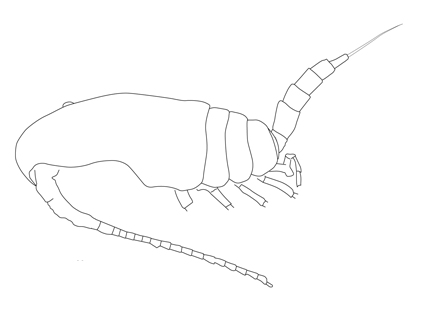Abstract
Two species of the calanoid copepod genus Bestiolina occurred in estuarine/coastal waters of the Nansei Islands, southernmost Japan. One of them is described herein as Bestiolina okinawae sp. nov., which is distinguished from known congeners by a combination of the following characteristics: 1) fifth pedigerous somite bearing groups of tiny spinules on the posterior end, 2) female mandible bearing a rod-shaped first gnathal tooth, 3) male left leg 5 with short apical spine on long terminal segment, and 4) legs 2–3 with endopodal segment 2 lacking spinules. The new species was the dominant zooplankter in oligohaline waters. The other species is morphologically identifiable to Bestiolina similis (Sewell, 1914). Genetic analysis using COI revealed that the two species differed by 9.9–10.0%, in contrast to small intra-specific genetic variation (0.0–1.5%). The two species were spatially segregated in low-salinity (2–30) estuaries and high-salinity (25–36) coastal waters, respectively, but co-occurred in some samples. Their body length decreased from the winter (around 20°C) to the summer (around 30°C) by 9.5–18.1%, depending on the species and sex. In both species, adult males, which lack mandibular gnathobase, were larger than the adult females.
References
Ali, M., Al-Yamani, F. & Prusova, I. (2007) Bestiolina arabica sp. nov. (Copepoda, Calanoida, Paracalanidae), a new species from the northwestern Arabian Gulf. Crustaceana, 80, 195–205. https://doi.org/10.1163/156854007780121429
Andronov, V.N. (1972) Veslonogie rachki Bestiola gen. n. (Copepoda, Paracalanidae). Bestiola gen. n. (Copepoda, Paracalanidae). Zoologicheskii Zhurnal, 51 (2), 290–292. [in Russian with English summary]
Boxshall, G.A. & Halsey, S.H. (2004) An Introduction to Copepod Diversity. The Ray Society, London, 966 pp.
Dorado-Roncancio, J., Gaviria, S., Bernal-De La Torre, L. & Ahrens, M.J. (2019) A new species of Bestiolina (Crustacea, Copepoda, Calanoida, Paracalanidae) from coastal waters of the Colombian Pacific, including a worldwide key for the identification of the species. Zookeys, 846, 1–18. https://doi.org/10.3897/zookeys.846.31497
Greenwood, J.G. (1976) Calanoid copepods of Moreton Bay (Queensland) I. Families Calanidae, Eucalanidae, and Paracalanidae. Proceedings of the Royal Society of Queensland, 87, 1–28.
Huys, R. & Boxshall, G.A. (1991) Copepod evolution. The Ray Society, London, 468 pp.
Katoh, K. & Standley, D.M. (2013) MAFFT multiple sequence alignment software version 7: improvements in performance and usability. Molecular Biology and Evolution, 30, 772–780. https://doi.org/10.1093/molbev/mst010
Koike, F. (1991) Taxonomic study of several estuarine copepods in Okinawa Island. Master thesis in Marine Sciences, University of the Ryukyus, Nishihara, Nakagami District, Okinawa, 123 pp.
Kumar, S., Stecher, G., Li, M., Knyaz, C. & Tamura, K. (2018) MEGA X: molecular evolutionary genetics analysis across computing Platforms. Molecular Biology and Evolution, 35, 1547–1549. https://doi.org/10.1093/molbev/msy096
Li, S. & Huang, J. (1984) On two new species of planktonic Copepoda from the estuary of Jiulong River, Fujian, China. Journal of the Xiamen University of Natural Scineces, 23, 381–390.
Mauchline, M. (1998) The biology of calanoid copepods. Advances in Marine Biology, 33, 1–710. https://doi.org/10.1016/s0065-2881(08)x6020-1
Moon, S.Y., Lee, W. & Soh, H.Y. (2010) A new species of Bestiolina (Crustacea: Copepoda: Calanoida) from the Yellow Sea, with notes on the zoogeography of the genus. Proceedings of the Biological Society of Washington, 123, 32–46. https://doi.org/10.2988/09-12.1
Nishida, S. (1985) Pelagic copepods from Kabira Bay, Ishigaki Island, southwestern Japan, with the description of a new species of the genus Pseudodiaptomus. Publications of the Seto Marine Biological Laboratory, 30, 125–144. http://hdl.handle.net/2433/176098
Oka, S., Saisho, T. & Hirota, R. (1992) Occurrence of Bestiola sinicus (Shen & Lee) (Crustacea: Copepoda) in the Nansei Islands, southwestern Japan. Bulletin of the Biogeographical Society of Japan, 47, 83–86.
Razouls, C., Desreumaux, N., Kouwenberg, J. & de Bovée, F. (2005–2021) Biodiversity of Marine Planktonic Copepods (morphology, geographical distribution and biological data). Sorbonne University, CNRS. Available from: http://copepodes.obs-banyuls.fr/en (accessed 6 February 2021)
Ronquist, F., Teslenko, M., van der Mark, P., Ayres, D.L., Darling, A., Höhna, S., Larget, B., Liu, L., Suchard, M.A. & Huelsenbeck, J.P. (2012) MrBayes 3.2: Bayesian phylogenetic inference and model choice across a large model space. Systematic Biology, 61, 539–542. https://doi.org/10.1093/sysbio/sys029
Sewell, R.B.S. (1912) Notes on the surface-living Copepoda of the Bay of Bengal. I and II. Records of the Indian Museum, 7, 313–382. https://doi.org/10.5962/bhl.part.28239
Sewell, R.B.S. (1914) Notes on the surface Copepoda of the Gulf of Mannar. Spolia zeylanica, 9, 191–262. https://doi.org/10.5962/bhl.part.7319
Shen, C. & Lee, F. (1966) On the estuarine copepods of Chaikiang River, Kwangtung Province. Acta Zoologica Sinica, 3, 215–223.
Suárez-Morales, E. & Almeyda-Artigas, R.J. (2016) A new species of Bestiolina (Copepoda: Calanoida: Paracalanidae) from the Northwestern Atlantic with comments on the distribution of the genus. Revista Mexicana de Biodiversidad, 87, 301–310. https://doi.org/10.1016/j.rmb.2016.05.002
Ueda, H. (1997) Paracalanidae. In: Chihara, M. & Murano, M. (Eds.), An Illustrated Guide to Marine Plankton in Japan. Tokai University Press, Tokyo, pp. 844–851. [in Japanese]
Ueda, H. & Hoshino, T. (2003) Copepoda. In: Nishida, M., Shikatani, N. & Shokita, S. (Eds.), The Flora and Fauna of Inland Waters in the Ryukyu Islands. Tokai University Press, Tokyo, pp. 225–230. [in Japanese]
Ueda, H. & Sakaguchi, S.O. (2019) Pseudodiaptomus yamato n. sp. (Copepoda, Calanoida) endemic to Japan, with redescriptions of the two closely related species P. inopinus Burckhardt and P. japonicus Kikuchi. Plankton and Benthos Research, 14, 29–38. https://doi.org/10.3800/pbr.14.29
Ueda, H., Yamaguchi, A., Saitoh, S., Sakaguchi, S.O. & Tachihara, K. (2011) Speciation of two salinity-associated size forms of Oithona dissimilis (Copepoda: Cyclopoida) in estuaries. Journal of Natural History, 45, 2069–2079. https://doi.org/10.1080/00222933.2011.574801
Vineetha, G., Madhu, N.V., Kusum, K.K. & Sooria, P.M. (2015) Seasonal dynamics of the copepod community in a tropical monsoonal estuary and the role of sex ratio in their abundance pattern. Zoological Studies, 54, e54. https://doi.org/10.1186/s40555-015-0131-xWalter, T.C. & Boxshall, G. (2021) World of Copepods database. Bestiolina Andronov, 1991. Available from: http://www.marinespecies.org/copepoda/aphia.php?p=taxdetails&id=346148 (accessed 5 February 2021)
Wellershaus, S. (1969) On the taxonomy of planktonic Copepoda in the Cochin Backwater (a south Indian estuary). Veröffentlichungen des Instituts für Meeresforschung Bremerhaven, 11, 245–286.


